Direct and indirect speech
There are two ways of conveying/reporting our speech.
Introduction
When we share what someone says, we usually do it in two ways: Direct Speech and Indirect Speech (also called Reported Speech).
Learning how to convert Direct Speech into Indirect Speech is a very important part of English grammar — and it often appears in exams, homework, and spoken English.
In today's blog, we will learn:
What Direct and Indirect Speech mean.
Simple rules to remember.
Lots of clear examples.
Common mistakes students make.
What is Direct Speech?
Direct Speech repeats the exact words that a speaker says. These words are written inside quotation marks (“ ”). Direct Speech also uses a reporting verb (like said, asked, told, replied) to show who is speaking.
Example:
Ali said, “I am going to the park.”
Here, the words “I am going to the park.” are the exact words Ali spoke.
We use Direct Speech when:
We want to repeat exactly what someone said.
We write stories or dialogue.
We want to show emotions or expressions clearly.
What is Indirect Speech?
Indirect Speech, also called Reported Speech, tells what someone said without using their exact words. We remove quotation marks and usually change the tense, pronouns, and some words.
Example:
Direct: She said, “I am tired.”
Indirect: She said that she was tired.
In Indirect Speech:
We don’t repeat the speaker’s exact words.
We change the tense back (in most cases).
We may change pronouns and time/place words.
We often use the word that (it’s optional in many cases).
When to Use Direct and Indirect Speech
Direct Speech: Good for telling stories, quoting people, or showing emotions.
Indirect Speech: Good for reporting what someone said later, summarizing, or writing formal reports.
Direct and Indirect Speech Rules
Learning these rules step by step makes it easy to convert Direct Speech into Indirect Speech.
Remove Quotation Marks
When changing Direct to Indirect, we remove the quotation marks.
He said, “I am hungry.”
He said that he was hungry.2. Change the Tense
If the reporting verb (said, told, asked) is in the past tense, the tense of the reported words usually moves one step back in time.
Direct: “I am happy,” he said.
Indirect: He said that he was happy.
Tip: If the reporting verb is in the present or future, the tense usually doesn’t change.
Example: He says, “I am fine.” ➜ He says that he is fine
Change Pronouns
Pronouns change depending on who is reporting and who is being spoken about.
“I love my cat,” she said. ➜ She said that she loved her cat.
“We are playing,” they said. ➜ They said that they were playing.
Change Time and Place Words
When reporting, words that show time and place often change.
Example:
Direct: He said, “I will call you tomorrow.”
Indirect: He said that he would call me the next day.
WH-Question:
Direct: She asked, “Where is your bag?”
Indirect: She asked where my bag was.
Change Commands, Requests and Advice
Commands and requests use to + base verb.
Direct: “Sit down,” the teacher said.
Indirect: The teacher told us to sit down.
Direct: He said, “Please help me.”
Indirect: He asked me to help him.
Negative commands: add not to.
Direct: “Don’t touch that!” she said.
Indirect: She told me not to touch that.
Change Exclamations and Greetings
Direct: He said, “What a beautiful day!”
Indirect: He exclaimed that it was a beautiful day.
Direct: She said, “Goodbye!”
Indirect: She said goodbye.
Advanced & Tricky Examples
With Modals:
Direct: He said, “I can solve this.”
Indirect: He said that he could solve that.Direct: She said, “I may go tomorrow.”
Indirect: She said that she might go the next day.
With Multiple Clauses:
Direct: She said, “If you study well, you will pass.”
Indirect: She said that if I studied well, I would pass.
Exclamations:
Direct: He said, “What a beautiful day!”
Indirect: He exclaimed that it was a beautiful day.
Greetings & Politeness:
Direct: She said, “Good morning!”
Indirect: She greeted me good morning.
9.Imperatives / Commands
Direct: The teacher said, “Sit down.”
Indirect: The teacher told us to sit down.Direct: He said, “Don’t touch it.”
Indirect: He told me not to touch it.
Some more examples
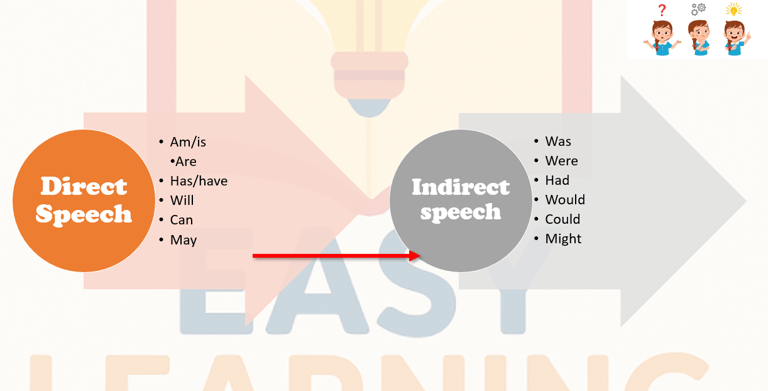

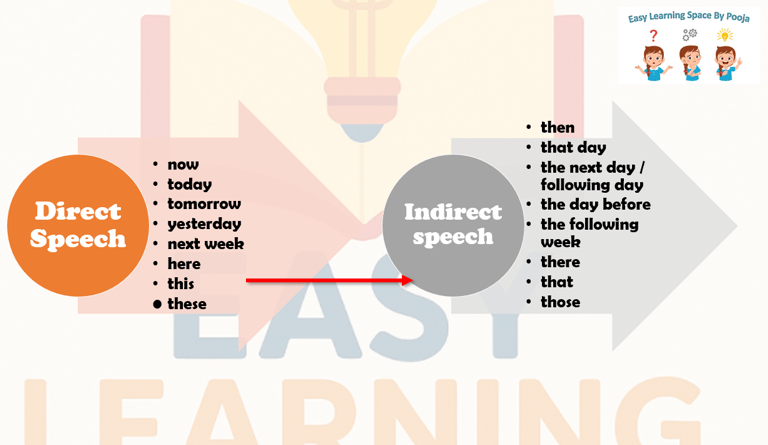

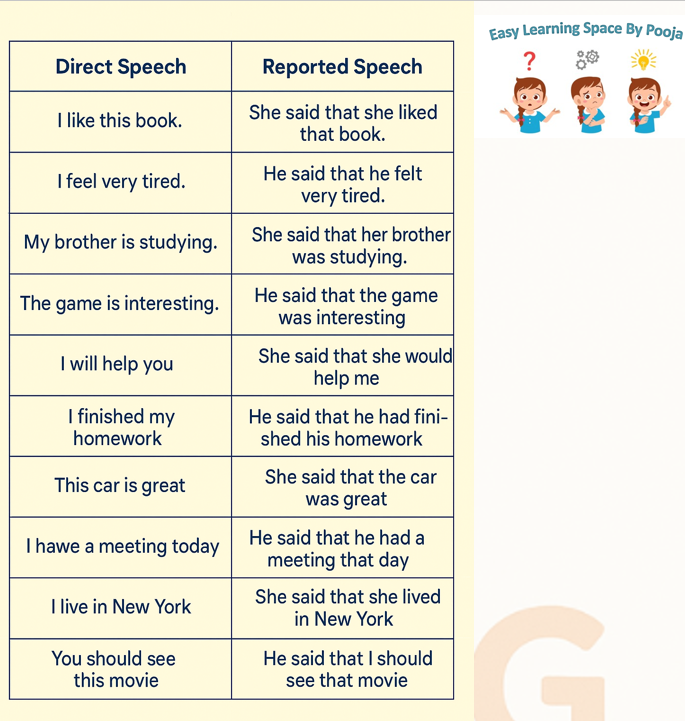

Call to action.
Sharing a few worksheets for your follow up activities. Meanwhile you can also check out
Understanding Verbs, regular and irregular verbs | Easy Learning Space by Pooja
Active voice and Passive Voice Techniques | Easy Learning Space by Pooja
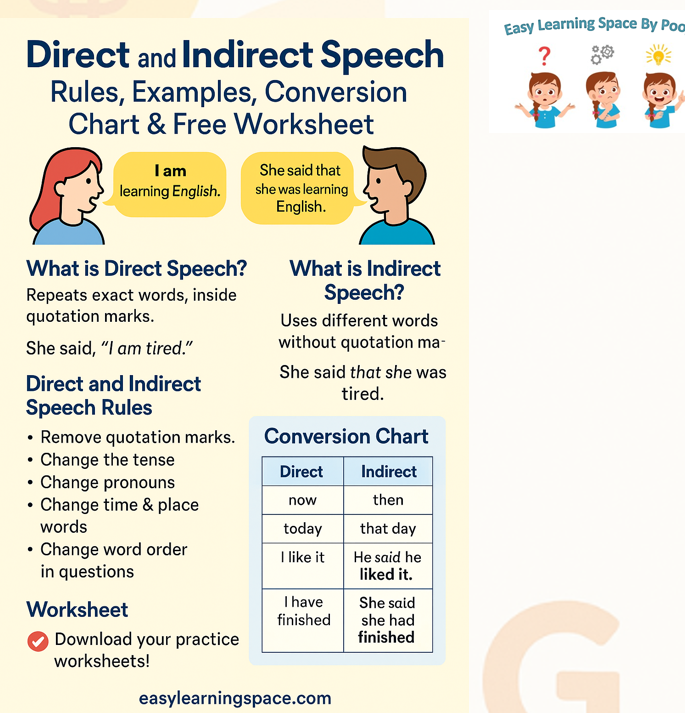
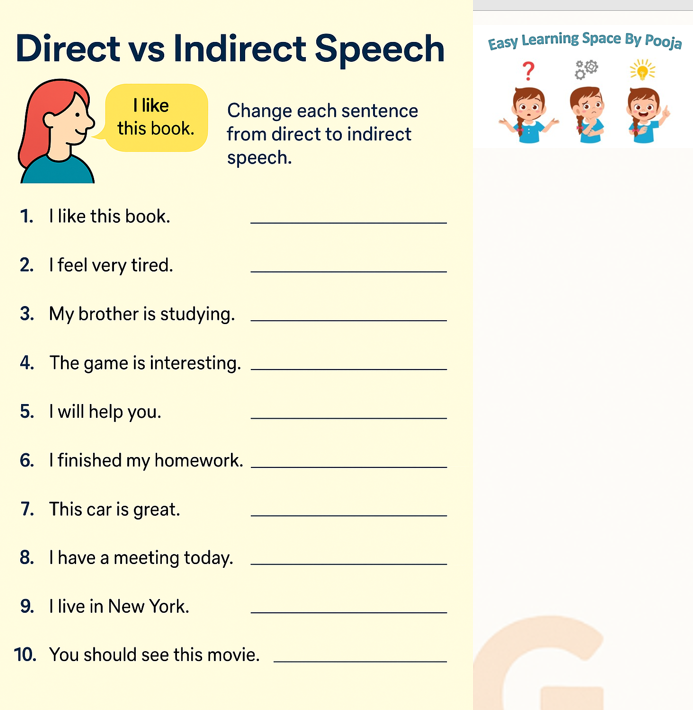
Address
Pooja
Bangalore
Contacts
easylearningspacebypooja@gmail.com
Subscribe to our newsletter
This blog is for educational purpose only
All the information on this website – www.easylearningspace.com – is published in good faith and for general educational and informational purposes only. I aim to provide helpful teaching tips and resources, but I make no warranties about the completeness, reliability, and accuracy of this information.
Any action you take upon the information you find on this website is strictly at your own risk. I will not be liable for any losses
